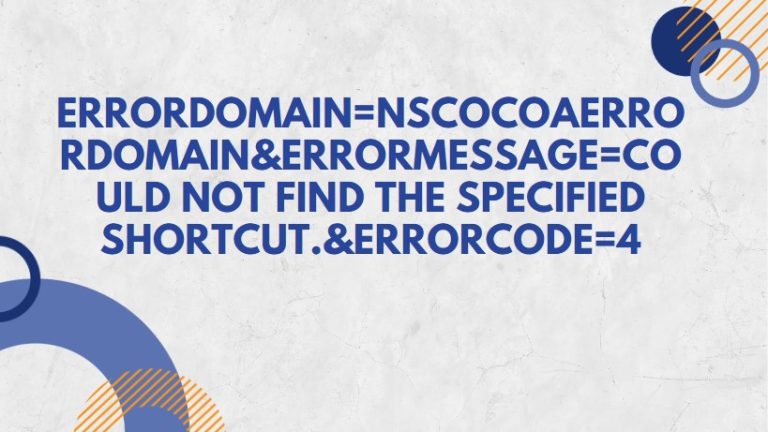In the world of software development, errors and exceptions are inevitable, and their effective handling is crucial for maintaining robust and user-friendly applications. One such error, frequently encountered by developers working with Apple’s ecosystem, is represented by the string: errordomain=nscocoaerrordomain&errormessage=could not find the specified shortcut.&errorcode=4. This article aims to delve into this error, unpack its components, understand its causes, and explore potential solutions.
Breakdown of the Error
The error message in question can be broken down into three primary components:
- Error Domain (errordomain=nscocoaerrordomain): The error domain is a broad categorization of errors that helps in identifying the source or the type of error. In this case, nscocoaerrordomain indicates that the error is related to Cocoa, Apple’s native object-oriented application programming interface (API) for macOS and iOS.
- Error Message This part of the error provides a human-readable description of what went wrong. Here, it indicates that the system could not locate a specified shortcut.
- Error Code (errorcode=4): Error codes are numeric values that further classify the error. Each code corresponds to a specific error scenario. Error code 4 in this context signifies a particular type of issue within the NSCocoaErrorDomain.
NSCocoaErrorDomain: An Overview
The NSCocoaErrorDomain encompasses a wide range of errors related to Cocoa APIs. These errors can occur in various contexts, such as file handling, data persistence, and user interface interactions. Common sub-domains include file system errors, key-value coding errors, validation errors, and formatting errors.
When working with macOS and iOS applications, developers frequently interact with APIs that can throw errors within the NSCocoaErrorDomain. Understanding the nuances of this domain is essential for debugging and resolving issues efficiently.
The Context of Shortcuts in macOS and iOS
Shortcuts in the context of macOS and iOS can refer to various elements such as keyboard shortcuts, automation shortcuts created using the Shortcuts app, or even URL schemes that provide quick access to specific functionalities within an application.
When the system throws an error indicating that it “could not find the specified shortcut,” it suggests that a requested shortcut could not be located or resolved.
- Missing or Deleted Shortcuts: The shortcut being referenced might have been deleted or is no longer available.
- Incorrect References: The application might be referencing a shortcut that doesn’t exist or has been incorrectly specified.
Common Scenarios
Automation Shortcuts (Shortcuts App)
The Shortcuts app on iOS and macOS allows users to create custom automation scripts. When an application or another shortcut tries to invoke a specific shortcut, and it cannot be found, this error may be thrown.
Solution: Ensure that the shortcut exists and is correctly named. Verify that the shortcut is accessible and not deleted. If the shortcut relies on other shortcuts or third-party apps, make sure those dependencies are also intact.
Keyboard Shortcuts
Keyboard shortcuts provide quick access to functionalities within an application. If an application attempts to use a keyboard shortcut that is not registered or recognized, this error might occur.
Solution: Check the application’s settings to confirm that the keyboard shortcut is properly defined. Additionally, ensure that there are no conflicts with other system-wide shortcuts.
URL Schemes and Deep Linking
URL schemes enable deep linking to specific parts of an application. If an app tries to open a URL that is supposed to trigger a shortcut and fails, this error can arise.
Solution: Verify the URL scheme and ensure it is correctly formatted. Make sure the target application supports the specified URL and the corresponding shortcut.
Debugging Steps
When encountering the errordomain=nscocoaerrordomain&errormessage=could not find the specified shortcut.&errorcode=4 error, developers can follow these steps to diagnose and resolve the issue:
- Identify the Context: Determine where and when the error occurs. Is it during app launch, a specific user action, or an automation script?
- Check Shortcut Existence: Verify that the shortcut being referenced exists and is correctly named. For automation shortcuts, open the Shortcuts app and confirm its presence.
- Inspect References: Ensure that any references to the shortcut within the code or automation scripts are accurate. Look for typos, incorrect names, or invalid URLs.
- Review Permissions: Check if the application has the necessary permissions to access the shortcut. For automation shortcuts, ensure that any required permissions are granted.
- Use Debugging Tools: Utilize debugging tools provided by Xcode (Apple’s integrated development environment) to trace the error. Breakpoints and logging can help pinpoint the exact location and cause of the error.
Best Practices for Preventing Shortcut Errors
To minimize the occurrence of errors related to shortcuts, developers can follow these best practices:
- Consistent Naming Conventions: Use clear and consistent naming conventions for shortcuts to avoid confusion and ensure easy identification.
- Validation Checks: Implement validation checks within the application to confirm the existence and accessibility of shortcuts before attempting to use them.
- Error Handling: Incorporate robust error handling mechanisms to gracefully manage scenarios where a shortcut might be missing or inaccessible.
- User Guidance: Offer guidance to users on how to set up or restore missing shortcuts. This can include in-app tutorials, documentation, or prompts to recreate necessary shortcuts.
- Regular Updates: Regularly update the application and its dependencies to ensure compatibility with the latest OS versions and API changes that might affect shortcut functionality.
Also Read : Euro Pare-Brise + Verdun Haudainville
Conclusion
The error errordomain=nscocoaerrordomain&errormessage=could not find the specified shortcut.&errorcode=4 is a common issue that developers may encounter when working with macOS and iOS applications.
By following best practices and employing systematic debugging techniques, developers can minimize the occurrence of such errors and ensure a smoother user experience. As with any error, staying informed about the latest updates and guidelines from Apple’s developer community can further aid in preventing and addressing issues related to shortcuts and other Cocoa-related functionalities.

